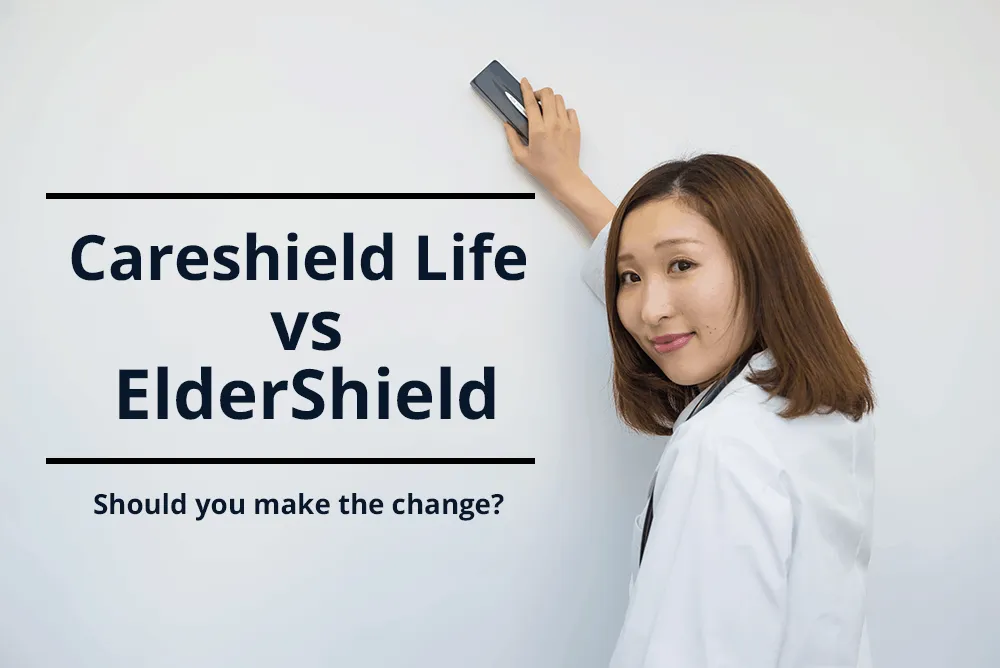CareShield Life, which is a new basic long-term care insurance scheme, is in operation in Singapore. This disability insurance scheme is not entirely a new thing. Before, it was known as ElderShield.
However, there are some critical differences between them regarding eligibility, premiums, premium payment term, and duration of payout.
All Singaporeans aged 40 and below will automatically come under CareShield Life from October 2020. And Singaporeans under this category will have no option to leave the scheme. So, if you’re one of them, this comparison article might not probably be relevant.
Please spend some time reading our guide on CareShield Life here.
However, if you’re more than 40 years old, this article is for you. The decision you need to make is to choose to stay with CareShield Life or opt-out altogether.
This article aims to provide you with pointers to help you make an informed decision. And through which, hopefully, you understand what suits you best while also not burdening you today.
What is Careshield Life and ElderShield?
Firstly, understand that both CareShield Life and ElderShield are severe disability plans that provide you with long-term care protection. They provide monthly cash payouts in cases of severe disability for policyholders.
ElderShield has been there since 2002. The Government of Singapore is only changing the name to CareShield Life from October 2020. Otherwise, they both serve the primary purpose, i.e., providing you with your long-term care needs.
Both schemes stick to the government’s definition of specifying ‘severe disability’- Anyone who cannot do at least 3 out of the 6 Activities of Daily Living (ADLs). These ADLs are dressing, toileting, washing, moving around, walking, and transferring.
However, bear in mind that qualifying for ADLs is alone not enough. You will need a certificate from a Ministry of Heath severe disability assessor to make any successful claims.
Once you qualify for the claims, you can expect to receive cash benefits that help you through the months (if not years) of your recovery.
Who is affected by this change?
Singaporeans born in 1979 or earlier will be affected by the change from ElderShield to CareShield Life.
If you’re born between 1970 and 1979, with ElderShield 400 plan, and are not severely disabled, you will be automatically enrolled into CareShield Life. You can choose to opt-out anytime from its launch to 31st Dec 2023. When opting-out, whatever you’ve paid will get refunded.
If you’re born before 1970, you have the option to join if you’re not severely disabled.
For those born between 1980 and later, you will automatically enroll in CareShield Life by mid-2021 or when you’re 30. Premium payments will continue till the age of 67 or whenever you retire.
Differences between Careshield Life and ElderShield
Let’s start by saying that CareShield Life is bigger and better than ElderShield. How? It has better coverage such as higher payouts, lifetime payouts, and has lower auto-inclusion age from 30 years old.
CareShield Life provides payouts of $600 monthly and increases by 2% each year, while ElderShield only has $300 and $400 payout.
With a 2% increase in payouts, your premiums increase by 2% yearly as well. ElderShield’s payment duration is from 40 – 65 years old, while CareShield Life is from 30 – 67 years old.
Also, not forgetting that if you are severely disabled, ElderShield’s payout duration is only for 5 or 6 years, while Careshield Life is a lifetime.
CareShield Life includes everyone with pre-existing medical conditions and severe disability, whereas, on ElderShield, it had ruled out pre-existing medical conditions.
The other significant difference between the two is, unlike in ElderShield, you will not be able to opt-out of CareShield Life after the stipulated date.
Should I change to Careshield Life?
Basic ElderShield Plan
If you’re just on the basic ElderShield plan (with no supplements), CareShield Life is much more beneficial if you can afford it.
You may be frustrated about the 2% increment, but you also get a 2% higher payouts. If it is any comfort, CareShield Life premiums are affordable, and a 2% increment is only for the first 5 years.
Here, your monthly payouts will increase as you continue paying. Supposing you never make any claims and continued paying – then at 67 years old, if you make any claims, your monthly payouts will be around $1,200.
If you make claims between 30 and 67, the private insurers will adjust your monthly payouts accordingly. Instead of starting the first payout at $600 monthly, this will be adjusted according to how old you are when making these claims.
Once you start receiving payouts, it will not increase and will remain fixed according to the age you first made your claims.
ElderShield did not include any government subsidies, but with CareShield, there are subsidies that you might qualify for. If you fall within this group of people who are eligible for the additional premium subsidies, CareShield is a desirable option.
You can also use your MediSave account to help make these payments.
Severe disability is a long-term problem, especially in Singapore. Having an insurance scheme providing you coverage for only for 6 years at the most may not sound comforting, especially if you’ll need long-term care.
CareShield Life is, on the other hand, offers lifetime cash payouts.
Basic ElderShield + ElderShield Supplements
As much as we would like to give you a definite answer, this scenario is pretty subjective. You will need to calculate how much coverage you’re currently receiving and how much you’re paying in total.
After this, you should determine if you’re more comfortable with your current fixed premiums or can afford to pay the increasing premiums.
Do take note that although a 2% yearly increase may sound a lot, there’s also an increase in premium yearly by 2%.
This is to help you counter inflation costs where your supplements may not take into consideration.
Our guide to ElderShield supplements might help.
Conclusion
When you consider everything, you can see how important it is to choose your insurance schemes wisely. There’s no one-size-fits-all solution.
If you need more information on ElderShield, we have a guide on ElderShield that should help you make a better decision for yourself.
Always do your own due diligence so that you can make the best choice for yourself.
When in doubt, ask a financial advisor for help.










